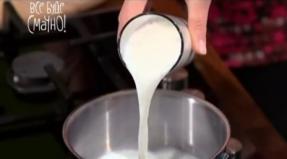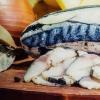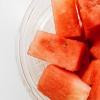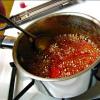Salting cabbage rosters in a barrel. Oak Barrel Sauerkraut Recipes
Cabbage must be fermented for the winter. It contains more vitamin C than lemons. It is also rich in other beneficial substances and bacteria that have a beneficial effect on human health.
Many housewives prepare vegetables in jars, buckets or casseroles. But originally sauerkraut was cooked in barrels. It is recommended to use oak containers, but if you do not have this opportunity, then prepare plastic barrels of the required volume.
Late varieties of vegetables are better suited for salting. The head of cabbage should be firm, without visible defects and signs of decay. The taste and shelf life of the snack depends on the quality of the product.
This is a fairly simple recipe. We will not use any extra ingredients. For home cooking, we prepare oak containers for 5 or 10 liters. The barrel must be thoroughly washed and dried beforehand.

Ingredients:
- 10 kg of white cabbage;
- 1 kg of carrots;
- 50 g sugar;
- 15 g black peppercorns;
- 50 g rye bread.
Preparation
Cut the cabbage and carrots into strips. If you have a food processor, the process is greatly simplified and shortened. Do not cut too thin, otherwise you will not get a crunchy snack.
To prevent the vegetables from withering, prepare them in portions.

In a saucepan or bowl, mix the ingredients, add salt and spices.

We will use rye bread as a leaven. We send one piece to the bottom of the barrel, and then chopped vegetables. We crush them with our hand so that the juice completely covers the appetizer.

Then we prepare the next batch and fill the oak barrel. Cover the top with gauze, put a lid of a smaller diameter, and then any load.

Close with a suitable lid and leave at room temperature for a couple of days. We pierce the cabbage every day to release gases.
After that, we transfer the barrel to a cooler place, where it should be about +8 degrees, and leave it for another three days. After this time, the snack will be ready. It should be stored in a room where the temperature does not drop below 0 degrees.
Sauerkraut for the winter with apples
You can prepare cabbage with fruit in an oak tub. The appetizer turns out to be not only tasty, but also crispy. Be sure to use this recipe, you will not regret it.

Ingredients:
- 20 kg of cabbage;
- 1.5 kg of carrots;
- 2 kg of apples;
- Salt according to preference (about 25 g per 1 kg of cabbage).
Preparation
Cut the cabbage in half and cut out the stump. Peel the carrots from the top layer and rinse. Then cut the vegetables into strips.

We send the cabbage in a large container, add salt and carefully knead it with our hands so that it starts up the juice. In the next step, add carrots and apple slices to the pan. Mix everything gently.

Now we shift the appetizer into a wooden barrel, cover it with a shield and put a load on it. Leave at room temperature for 2-3 days.

During this time, it is imperative to release gases, otherwise the taste and smell of the workpiece will deteriorate. To do this, we pierce the cabbage daily with a thin stick.
After that, we put the container on the covered balcony. A suitable temperature is about zero degrees. After a couple of weeks, you can try a snack.
How to ferment cabbage in a barrel with horseradish and garlic
If you prefer savory snacks, then you will love this recipe. For example, we will harvest vegetables in a small barrel, if you have a large capacity, then increase the amount of products proportionally.

Ingredients:
- 6 kg of cabbage;
- 300 g carrots;
- 2 heads of garlic;
- 200 g horseradish root;
- 70 g sugar;
- 140 g table salt;
- 150 g ginger.
Preparation:
- Cut the cabbage into strips or pieces, as you like;
- Grind the carrots on a medium grater;
- Peel the garlic, divide into cloves and cut into thin plates;
- Horseradish root and ginger are grated;

- We send all products to a large bowl or pot. Add salt and mix with light pressure so that the vegetables let out the juice;

- We shift the appetizer into a barrel, cover it with cabbage leaves on top and put some kind of press. We leave for several days at room temperature;
- We pierce the workpiece every day to release gases, otherwise an unpleasant odor will appear;
- After three days, remove the sauerkraut to a cooler place.
Thanks to garlic and horseradish, the appetizer retains its taste and freshness for a long time. Bon Appetit!
By the way, if you like hot seasoning, then you can.
How to ferment cabbage in a barrel at home so that it is crispy
Now let's look at a classic recipe for an appetizer with the addition of berries. The vegetables are delicious and crispy. We need a small oak barrel. You can use a plastic container.

Ingredients:
- 1 forks medium-sized cabbage;
- 1 large carrot;
- 60 g cranberries;
- Salt according to preference.
Preparation
We remove the top leaves from the head of cabbage, but do not throw them away, they will still be useful to us. Divide the forks into several parts and cut out the stump. Chop the cabbage, salt and knead it thoroughly with your hands.

The next step is to add the grated carrots and mix, but do not knead with your hands.

Put the cabbage leaves on the bottom of the keg, and then lay the prepared vegetables tightly. Add cranberries periodically. The last layer should be cabbage.

Now we cover the tub with a lid and a heavy load on top. We leave for 8-10 days in a dark place.

Every day we pierce the cabbage with a wooden skewer, since in the presence of gases, the snack will not ferment, but simply rot.
Harvesting whole cabbage for the winter
The vegetable can be fermented with whole heads of cabbage. A plastic barrel is suitable as a container. At first glance, it may seem that the cooking process is complicated, but any housewife can handle it.
For detailed instructions, see the following video:
You can use these methods to stock up on a tasty and healthy snack for the winter. Today it is not difficult to buy a wooden barrel. It is sold in specialized stores. But plastic containers are also good for pickling vegetables.
If there is no more space left in the freezer, and there is nowhere to put the next portion of vegetables from the garden, it is time to remember how our ancestors made the preparations. Cabbage, fermented in a barrel for the winter according to an old classic recipe, was so tasty from our grandmothers that there was no end to those who were eager to taste it. To prepare delicious pickles, you will need a large wooden container, a large shredder, a table, and, of course, fresh vegetables from your own garden.
In the absence of your own vegetable garden, you can also ferment purchased cabbage. It is very important to choose the right one, because not every one is suitable for putting in a barrel.
The ideal option is to take forks with white leaves of late varieties, cut in October, before frost. Such a cabbage leaf crunches pleasantly, and the juice in it is enough for sourdough.
When choosing heads of cabbage, you need to press them slightly: those that emit a pleasant light crunch are suitable.
Barrel for pickling cabbage
Our grandmothers fermented cabbage and prepared other pickles in oak barrels. Oak is a strong wood that does not rot. On the contrary, it has a powerful disinfecting effect, and the products that are stored in oak containers never go missing. In addition, it gives the salty a special flavor.

A barrel that has been in the barn for a long time needs to be prepared. One of the ways our ancestors used was steaming. Several freshly cut juniper branches should be placed in a container, filled with hot water. Almost immediately, you should throw a few clean hot stones into it, after which you need to cover the barrel.
After the water has cooled, we take out all the contents from it and rinse it thoroughly using a soda solution. If the container has not been used for a long time, it, of course, has dried out, and it needs to return to working capacity by flooding it with water and letting it stand for several days. During this time, the wood will swell and close all cracks formed from drying out.
Sauerkraut in bokeh: a rustic classic recipe

Ingredients
- Cabbage heads fresh- 10 kg + -
- - 1 kg + -
- - 200-250 g + -
- - about 1 tbsp. + -
- Fresh cranberries - 300 g + -
How to properly ferment cabbage at home
- We cover the bottom of a wooden container (it needs to be slightly dried) with large cabbage leaves. They need to be laid very tightly so as not to leave the slightest gap between them.
- It is not necessary to wash cabbage before shredding - you just need to free the forks from dry and spoiled top leaves. We cut it into halves or quarters - so that it is convenient to chop. If the forks are from your own organic garden, the stumps can be left on and shredded with them.
- Having chopped a fifth of the cabbage forks, we send them to the barrel, pouring carrots chopped on a coarse grater. Consumption - 200 g of grated root vegetables for 2 kg of cabbage shavings.
- Putting one serving of vegetables in the barrel, mix them well, crushing slightly until crunchy.
- The next step is adding salt. One bookmark needs about a handful. We mix well again, slightly crushing.
- Add a fifth of washed cranberries and dill seeds, stir again, but gently. When cranberries have already appeared in the cabbage, you do not need to crush it, so as not to crush the berries.
- Again we take a shredder in our hands, chop the next portion of cabbage, add it to the barrel, mix with carrot shavings, mash, salt, add berries and dill.
We do this with enviable constancy until we fill the salting container almost completely. It is not worth filling the barrel to the top, so that during the fermentation process the juice does not overflow over the sides.
Cover the filled container with a piece of clean cloth or gauze, cover it with a wooden circle or plate of the same diameter as the neck of the barrel, and put the load on top. He must press down the contents of the oak container so that the juice completely covers it.
After a day, open the barrel and pierce the cabbage with a clean stick. Leaning against the bottom, we begin to make circular movements in order to release the gases accumulated in the container. This should be done twice a day - in the morning and in the evening.
Having reduced the oppression, we leave the cabbage to ferment at a temperature of up to 18 ° C for about 1.5 weeks. If the room is colder, the fermentation process will take a little longer.
Secrets of a successful cabbage sourdough
- Salt for home salting cabbage for the winter in an oak barrel must be taken the most common, large. Enriched with iodine is not suitable, as it leads to a softening of the product. Its amount can be varied to taste, but the most optimal proportion is 1 tbsp. (with a slide) for 1 kilo of shredded cabbage.
- If you add Antonovka apples to the barrel, the cabbage will become even more vigorous and aromatic. They can be laid (in layers) either whole or by dividing them into quarters or large slices.
- Shredded cabbage can be layered with coarsely chopped leaves or even quarter-cut small forks.

An indicator that our pickles are already ripe is the clarification of cabbage juice and the absence of gas emissions. It is advisable to keep the finished product in the same container, remembering to air it sometimes, in the dark and cold. At a temperature of 0-4 ° C, the cabbage delicacy will be stored at least until spring.
Fragrant skits, filling for homemade pies, spicy stewed garnish for a fried neck - none of these dishes can be prepared without delicious salting. Favorite sauerkraut, prepared in a barrel for the winter according to an old recipe, is a fertile topic for an unbridled culinary fantasy. But just sprinkled with fragrant sunflower oil in the "company" with a green onion, it is incomparable! ..
One of the simplest, most delicious and economical dishes is sauerkraut. And the knowledge of how to salt cabbage in a barrel will never be superfluous, since this cooking method allows you to get a real delicacy. Many housewives have their own family secrets, passed down from generation to generation, and providing the unique taste of sauerkraut in barrels.
How to choose cabbage for sourdough
The best head of cabbage for sourdough will be the one that is cut at the beginning of October, before the first frost. Late varieties of cabbage are ideal for sourdough. The most crunchy and mouth-watering sauerkraut comes from light, almost white heads of cabbage.
When choosing a cabbage fork, you need to squeeze the head of cabbage a little, it should crunch. It is also worth paying attention to whether the top leaves of the cabbage are not cut off, as this may mean that the cabbage is frozen over, and the seller cut them off to hide it.
How to prepare barrels for sourdough cabbage
In the event that the barrels were stored in a cool place, it will be enough to rinse them with ordinary baking soda and rinse them with boiling water. Then the barrels need to be filled with water and left for a week, at first there may be a slight leak in the connector areas. After the wood swells with water, the flow will stop.
When fermenting cabbage in oak barrels, the taste is rich, natural and pleasant. But the use of plastic dishes does not affect the taste of cabbage in the best way, spoils it, since plastic does not allow air to pass through.
 Barrel is considered the tastiest. This method of salting is not very popular today, since most housewives prefer to ferment cabbage directly in jars. However, it is the barrel ambassador using old technologies that allows you to get the most delicious and crisp cabbage.
Barrel is considered the tastiest. This method of salting is not very popular today, since most housewives prefer to ferment cabbage directly in jars. However, it is the barrel ambassador using old technologies that allows you to get the most delicious and crisp cabbage.
It is important to remember that when choosing salt, you should give preference to simple rock salt, the use of iodized salt can lead to softening of the cabbage. On average, the concentration of salt should be one tablespoon per kilogram of shredded cabbage. This amount of salt will be enough if you salt the cabbage with the addition of brine. If cabbage is cooked without brine, then the amount of salt must be slightly increased.
It is advisable to chop the cabbage not very finely. Some housewives cut the vegetable into squares, or into several pieces. It is possible to use the stump when fermenting only if there are no nitrate compounds in it. That is, cabbage grown with your own hands can be salted along with the stump, but if the head of cabbage was purchased from an unknown seller, then it is better not to risk it.
 Most often, when fermenting cabbage, grated carrots are added to it, it gives a pleasant aroma, makes the cabbage more crispy. Lingonberries can be added to increase acidity.
Most often, when fermenting cabbage, grated carrots are added to it, it gives a pleasant aroma, makes the cabbage more crispy. Lingonberries can be added to increase acidity.  , cranberries, sour apples. To change the usual color of cabbage, you can add beets
, cranberries, sour apples. To change the usual color of cabbage, you can add beets  , and then the shredded cabbage will take on a raspberry color. It will not be superfluous to add black and allspice, fresh hot peppers, cloves, caraway seeds to the cabbage.
, and then the shredded cabbage will take on a raspberry color. It will not be superfluous to add black and allspice, fresh hot peppers, cloves, caraway seeds to the cabbage.
It is best to store sauerkraut in the cellar; if it is not available, you can use the refrigerator for storage. The optimum storage temperature is 0 to 2 degrees Celsius. Negative temperatures have a bad effect on the taste of cabbage - after defrosting, the workpiece becomes too soft, it stops crunching.
If you want to ferment cabbage in a barrel, you must follow certain rules. For example, it is recommended to sprinkle the bottom of the barrel with rye flour, then lay a layer of chopped cabbage, a layer of salt, and a layer of grated or chopped carrots. When laying, cabbage should be lightly tamped, but not too much, so that it does not become soft later.
After stacking, you need to leave a little space in the barrel, that is, you should not fill the container to the brim, otherwise the juice may spill out of the barrel. Cover the cabbage with clean cabbage leaves, then boiled cotton cloth and a clean wooden circle (you cannot use plywood or chipboard, as they contain harmful substances that can pass into cabbage). Oppression is laid on a wooden circle.
Cabbage is fermented at room temperature for two weeks. The lower the temperature, the longer the leavening process will take. The foam that will appear during the fermentation process must be removed. Periodically, it is recommended to pierce the contents of the barrel with a long, clean rod to release the gas. After the end of fermentation, the cabbage is placed in a cool place with a temperature of no more than three degrees. The cabbage should always be covered with brine during fermentation.
 You can ferment cabbage not only chopped, but whole. To do this, you need to remove the upper leaves, cut out the stump, or simply cut it with a cruciform incision so that the salting passes evenly. The removed top leaves can be used to fill in the voids between the heads in the top rows. You need to try to lay cabbage evenly, halves of carrots are placed between the cabbage heads. Tomatoes and bell peppers can be added, this will also greatly improve the taste of the sauerkraut.
You can ferment cabbage not only chopped, but whole. To do this, you need to remove the upper leaves, cut out the stump, or simply cut it with a cruciform incision so that the salting passes evenly. The removed top leaves can be used to fill in the voids between the heads in the top rows. You need to try to lay cabbage evenly, halves of carrots are placed between the cabbage heads. Tomatoes and bell peppers can be added, this will also greatly improve the taste of the sauerkraut.
The laid cabbage is poured with brine (350-400 g per 10 liters of purified water), cabbage heads on top  covered with a linen cloth, a cross and a load. Traditionally, clean (preferably boiled) stones are used as cargo, which are chemically neutral and do not affect the taste of cabbage in any way.
covered with a linen cloth, a cross and a load. Traditionally, clean (preferably boiled) stones are used as cargo, which are chemically neutral and do not affect the taste of cabbage in any way.
The fabric should be regularly washed and boiled to get rid of the formed mold. The crosspiece and the load should also be periodically treated with antiseptics to avoid mold growth.
Sauerkraut, should be in every family, because it is a storehouse of vitamins that will help our body cope with vitamin deficiency.
Before lemons appeared in Russia, our sailors, setting off on long voyages, stocked up with barrels of sauerkraut, which prevented an epidemic of scurvy.
Sauerkraut, on winter evenings, can be eaten as an independent dish, or you can cook from it: salads, borscht, pies and many other dishes.
During the fermentation and maturation process, enzymes and bacteria are formed in cabbage, which have a beneficial effect on our intestines.
There are many recipes for sauerkraut, but I will tell you about the classic preparation, without any additives ...
If you are interested in this recipe, then let's start preparing it.
The original composition of the products.
As we can see, our blank has a simple composition: cabbage, carrots, coarse salt, dill umbrellas and bay leaves.
Recipe composition:
Step by step description
1. Preparation of carrots.


I prepare the carrots first, because then it is convenient to just take it and add it to the cabbage.
The carrots need to be washed well, and then using such a knife I easily remove the top layer.


Peeled carrots, I chop in a meat grinder. For these purposes, there is a nozzle (with a middle cell), which quickly and easily chops the required amount of raw materials.
If suddenly you do not have such a nozzle, then you can chop carrots on a coarse grater. A medium to fine grater will not work as carrots turn into porridge.
This is the size of the carrot.
2. Shred cabbage.



We take a fork of cabbage, peel off the top, damaged and green leaves from it and cut the head of cabbage into four parts.
Cut a stump from each quarter.
We easily shred cabbage with a special knife. True, just forks, it is inconvenient to cut on the table, so I built a small platform from two wooden boards (2 cm thick each), with which it became convenient to perform this procedure.
If there is no such knife, then you can chop the cabbage with an ordinary knife. Just try to keep the cabbage strips as thin as possible.
3. Putting the cabbage together.



Pour shredded cabbage into a 5 liter bowl, add a small handful of salt and grind strongly (as if washing clothes), until the first juice appears.
Try cabbage, if there is little salt, then add more. The cabbage should be slightly salted to taste.


Now add a good carrot menu to the grated cabbage and mix until smooth.
You can take a smaller amount of carrots than in the recipe, unless of course you really like it, but you can’t do without it.



We take a container of at least 30 liters, lay out the bottom with clean, green leaves, which were previously removed when cleaning the cabbage head.
Then pour the contents of the basin into the barrel and smooth out the layer.


Now the cabbage layer needs to be tamped, for this we use a heavy bottle, which must first be filled with water.
For these purposes, a champagne bottle is quite suitable, as a last resort, if there is no such bottle, then we fill an ordinary plastic bottle with water.
You need to tamp the cabbage before the first juice appears.
After tamping, put 1 bay leaf and a dill umbrella.
And so, layer by layer, we repeat until all the cabbage is finished.



Cabbage in a barrel, now we cover the top as well as the bottom of the container, i.e. clean green leaves.
Cover the leaves with clean gauze.
During fermentation, every day, cabbage will need to be pierced to the very bottom in 5 places with a long knife, and also rinsed with gauze in cold water.
Pierce the cabbage gently so that the bitterness that will form during the cooking of the cabbage comes out.



On top of the gauze, we put a wooden circle, I don't have one, so I used a plastic dumplings.
Now we need to purchase a heavy stone, which we previously washed in hot water and soap, and only then we put it in a bag and put it on a circle.
The container with cabbage should be in a warm place, in my kitchen under the window.
Prepare sauerkraut for a week.
Put the finished cabbage in jars, cover with lids and put it in a cool place.
Happy preparation!
I wish you good luck with your cooking crispy cabbage ! I would be glad if you like this recipe.

Composition:
Fresh cabbage - 10 forks
Carrots - 1.6 kg
Salt - 320 gr.
Bay leaf - 5 pcs.
Dill - 3 umbrellas
Happy preparation!

Composition:
Fresh cabbage - 10 forks
Carrots - 1.6 kg
Salt - 320 gr.
Bay leaf - 5 pcs.
Dill - 3 umbrellas
We begin to ferment cabbage for the winter.
1. First of all, rub the washed, peeled carrots on a coarse grater.
2. Peel the head of cabbage from the top leaves and cut into four parts.
3. Remove the stump from each part and finely chop it.
4. Put 850g of chopped cabbage in a 5-liter bowl, add a small handful of salt and grind everything well (as if washing clothes), until the juice appears. You need to salt the cabbage with a margin, i.e. slightly oversaline.
5. Add a handful of grated carrots to the cabbage and mix everything thoroughly.
6. Place the bottom of the container (at least 30 liters) with clean, green leaves that were previously removed from the fork when it was cleaned.
7. Pour the prepared cabbage from the basin, level it in an even layer and tamp it with a bottle of water until the juice appears easily. Put 1 bay leaf and 1 dill umbrella on top. We carry out this procedure until the cabbage runs out.
8. Cover the top layer with clean, green cabbage leaves, clean gauze, a wooden circle and a heavy, clean stone.
9. Cabbage should stand in a warm place for 7 days, and once a day it should be pierced in several places with a long knife to release the bitterness. You also need to rinse the gauze every time.
10. Put the ready-made cabbage in 3-liter jars, cover with lids and put in a cool place.
Happy preparation!


















